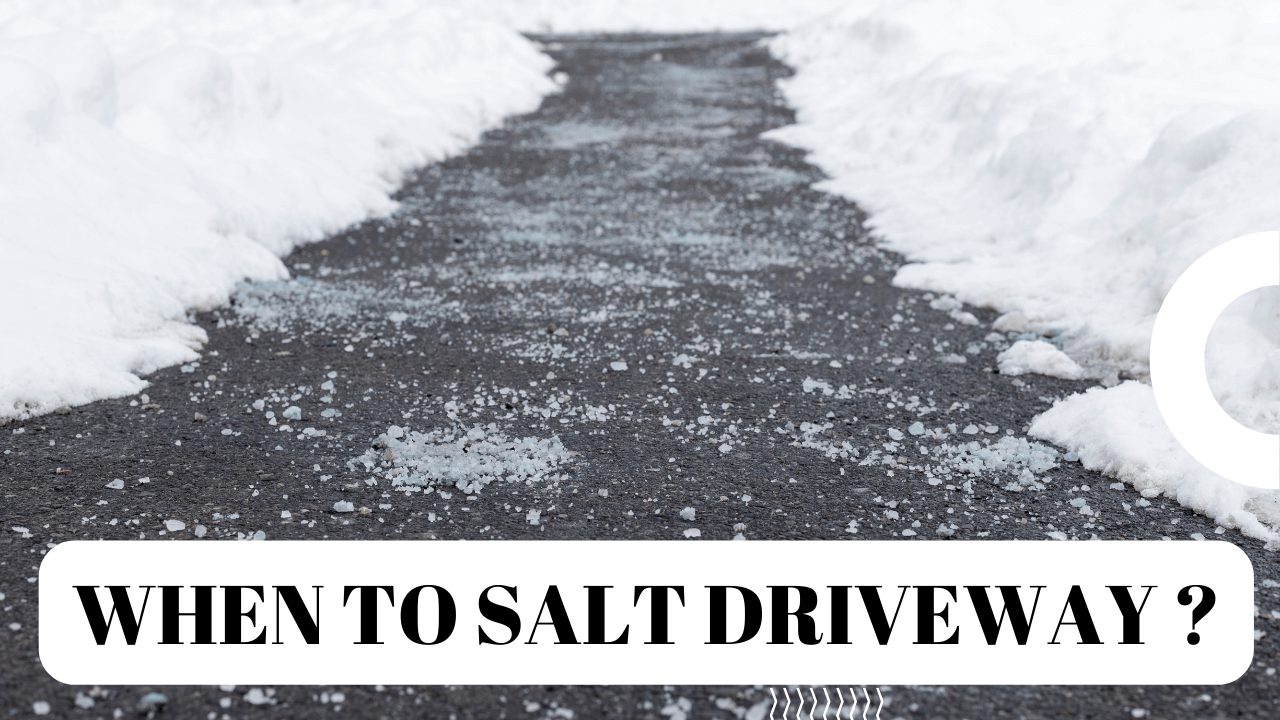It’s critical to have a clear driveway when inclement weather strikes. In the event of snow, sleet, or freezing rain, though, you may be asking when the optimum time is to salt a driveway.
Are there any salt substitutes that can assist keep driveways clear and save the time spent removing ice and snow? We researched to assist you in finding practical driveway solutions.
Getting rid of snow, ice, and sleet from the driveway before leaving can be a real pain. Knowing when to use salt is therefore crucial for safe mobility. To avoid ice accumulation behind a layer of uncovered snow, put down rock salt after you shovel. It is recommended that ice melt be applied ahead of a snowstorm to make snow removal easier.
Table of Contents
What’s The Purpose Of Salt On The Driveway?
It’s a widespread misunderstanding that driveway salt will melt ice, but this isn’t true. Salting your driveway does not melt it; instead, it changes the chemistry of the water.
The freezing point drops when you add salt to the water, indicating the water will only freeze at a lower temperature. So, even with a liberal quantity of salt, if the freezing point of your driveway isn’t lowered sufficiently, you’ll still have plenty of ice on your driveway.
Understanding how salt works might assist you in determining the type of salt your driveway needs. Salt lowers the freezing point of water to varying degrees. So, consider how cold it can get in your area. It’s also worth noting that some salts can cause harm to your driveway and landscape, as well as be hazardous to your pets.
When Do You Use The Salt On The Driveway?
Before a heavy snowstorm, you should ideally spread salt on your driveway. However, if you’ve lost your window of opportunity, it’s better to shovel the driveway before adding salt, as starting with a bare road will require less de-icer in the long run.
Although the low cost of road salt makes it an appealing de-icing solution, it might harm your lawn or garden. When the temperatures are warm enough for salting your driveway and sidewalk, it takes a few hours for the salt to work. Consider salting the night before if you want a safe location to walk in the morning.
When snow falls on top of the salt, the snow beneath it begins to melt. By compressing the snow, vehicles driving over it will assist the snow combine with the salt more quickly.
As a result, any vehicle movement will hasten the process. If there is no prolonged traffic, a thin layer of ice may form on top of the snow until the salt works its way up from below.
Alternatives For De-Icing
If you don’t have time to salt ahead of time and need a safe path to walk on, sand is your best option. Sand does not melt ice or snow, but it does provide traction, preventing you from slipping and falling.
The more you walk on it, reducing its usefulness, the more sand quickly gets ground into the ice and snow, which is one of the drawbacks of utilizing it. Sand will not prevent ice from forming as effectively as rock salt or other dicing chemicals, but it will give grip on slick sidewalks.
1) Use Coffee Beans
Used coffee grounds are a common natural ingredient for melting ice, and it has two advantages. One, because coffee grounds are inherently acidic, they will melt any ice that comes into contact with them if sprinkled on a recently shoveled driveway.
Second, the texture of coffee grounds is comparable to that of sand, which aids traction when driving or walking on the surface.
2) Calcium Chloride
Calcium chloride doesn’t harm your plants, but it will corrode metal and cause irritation to your pet’s sensitive paws. In cold weather, it’s ideal. Because it can leave a residue on carpets and shoes, please don’t bring it into your house with you.
3) Carbamide
This de-icer, also known as Urea or carbonyl diamide, can cause your lawn and plants to burn. It promotes algae blooms in rivers due to its high nitrogen content. It’s best to avoid it.
Use Salt For Ice Not For Snow
First and foremost, the salt is for ice rather than snow. Snow can fall as light and fluffy flakes, but due to the weight of the snow and foot traffic, it can be compacted into slick and deadly ice. Anti-freezing compounds, such as calcium chloride, can assist you and your neighbors avoid the risks of ice.
Salt reduces the freezing point of water, preventing ice or frost from developing on roadways—the high proportion of salt aids in lowering the mixture’s freezing point.
The success of utilizing ice melt to clear a driveway is because it creates a barrier that prevents ice from forming. Keep in mind that various ice melts are more effective at different degrees and weather circumstances. So, check what temperatures your choice of ice melt covers.
If you have children, pets, or wish to avoid salt harm, use ice melt instead of salt. As the seasons change, don’t rely on rain to wipe away the salt. To protect surfaces from salt damage, scoop up any residue left behind and wash them down.
Conclusion
Pre-salting the road creates a separating layer that prevents snow from freezing to the road surface and allowing it to be readily removed. As a result, we recommend salting driveways before snowfall, as it is always more accessible and more efficient.
We want you to feel confident in your decisions, whether you use rock salt, ice melt, or another snow-clearing solution.
Knowing when to apply rock salt to your driveway reduces time spent clearing snow, allowing you to get back on the road faster.





